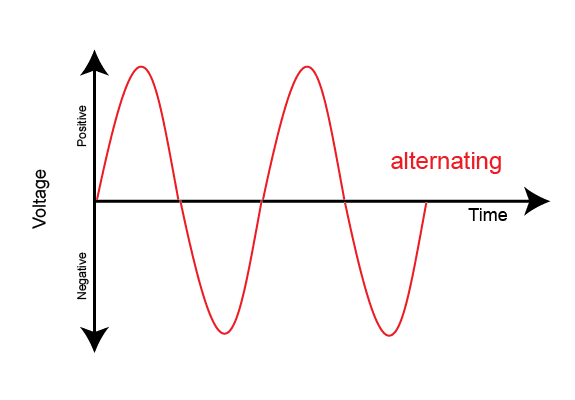What is Alternating Current?

AC refers to the way the current is flowing in a circuit where it is alternating periodically back and forth. If you remember mathematics in school what a sine chart looks like, it is easier to visualise what is happening to the AC power. The back and forth change in direction is called its frequency and is expressed in Hertz. By looking at the hertz, we are able to determine how many times the current reverses its direction per second. To help you visualise, refer to the image below.
In Australia, our domestic household power supply is 240 volts AC, 50 hertz (Hz). This means that the direction of current is switching back and forth at a rate of 50 times per second. The switch is so fast that your household appliances do not have the chance to stop working.
How does alternating current work?
Typically, alternating current is generated by using a device known as an alternator. The alternator is a device which generates an alternating current from a source of motion, such as a turbine powered by steam, windmill, turbine or even flowing water. To generate alternating current, a loop of wire is carefully spun inside of a magnetic field. The magnetic field induces current along the cable. The wire is made to rotate through the aid of a steam or wind turbines. Here, the spun cable spins thus entering varied magnetic polarity periodically, implying that the voltage, as well as the current, will alternate on the wire.
Who invented alternating current?
The first alternator was built in 1835 in France by a man named Hippolyte Pixii. It was a device that required to be hand cranked to rotate a magnet to generate alternating current (AC). It wasn’t until the early twentieth century that AC power became the world standard for electricity. Early pioneers of AC including Nikola Tesla, Karoly Zipernowsky, Otto Blathy and Miksa Deri had a big influence in developing AC power to the way it currently is now.
History of alternating current
During the early 1880s, both inventors and businesses wanted to find the most effective way to use electrical energy to power their homes as well as to power street lighting. This need is known to have sparked a supremacy battle between alternating current and direct current, famously known as the war of currents. During this same period, Thomas Edison had constructed a DC power station for his city neighbourhood of New York. Later, another physician and investor, Westinghouse George, purchased patents for AC power motors and transformers from Tesla Nikola, who was an investor.
Even as Edison was busy creating his own DC power plant, Westinghouse and Nicola Tesla together with his business partners were busy building their patented AC power firm in Great Barrington, Massachusetts. Westinghouse continued to promote the benefits of alternating current over direct current, by arguing that alternating current could potentially transmit energy more efficiently over large distances as opposed to its rival, direct current.
Typically, Edison’s direct current system demanded that power plants be located within a few miles of clients. Westinghouse and Tesla, on the other hand, believed that alternating current system had the potential to deliver electrical energy hundreds of miles away from the plants.
As the battle continued, the whole world slowly started to believe that alternating current was the best. By the early parts of the twentieth century, virtually all power distribution globally was achieved through alternating current. Thanks to its potential benefits, even today we transmit power via alternating current.
Why is AC used?
We commonly use alternating AC electric energy to power our lights, televisions, computers, and just about anything in our homes. This is because it has proven to be effective at supplying electricity than DC. As we previously mentioned, the voltages in AC current can be altered or transformed and this makes it relatively easier to be transported across great distance than DC, whose transformation may require relatively more complex electronic circuitry. Simply put, it only requires a transformer to convert its voltage levels and to be transported across distances. Such an advantage offered by AC makes it be easily used in electric generators, power distribution systems and motors.
Is alternating current dangerous?
First and foremost, it is imperative to note that all types of electric current, whether from DC or AC, are dangerous. No matter what, if either DC or AC comes into contact with your body, it can be hazardous.
However, it is the actual effect that varies because it depends on a number of factors including the duration of contact, the amount of current administered, the voltage applied, the pathway of the current as well as the impedance of the affected body. Several experiments have been conducted to help determine the most dangerous type of current, and findings always give one common answer; the AC current.
Alternating current is believed to be four to five times relatively more hazardous than direct current. Research has proven that in the case of an electric shock involving AC current, the affected person undergoes a series muscle contraction, which results in very severe muscle damage. Simply put, AC current can be dangerous. This only implies that prudent safety measures must be taken into consideration when the working device that uses AC current.
If you’d like to know more, read our article on alternating current vs direct current. In any case, feel free to reach out to our licensed electrician from Gordon’s Powers for all your electrical services in Sydney.












